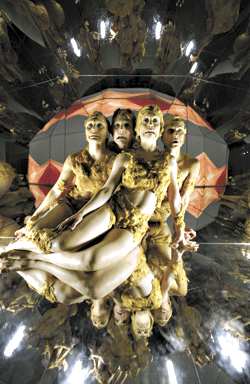Northwest New Works is On the Boards’ annual crapshoot, and this year’s edition pays off big—both with groups working beyond the conventional edge and others wringing changes on more familiar territory.
The strangest participant at the performance last weekend was probably the tEEth ensemble from Portland, which included a woman wearing a stag’s head, a quartet of dancers that looked like they were chipped out of rock, and a duo costumed in shiny rubber bathing suits. They proceeded to do exactly what you didn’t think they’d do—oddly and exquisitely, making familiar bodies mysterious. The duet couple clung together without using their hands until they looked like a four-legged, two-headed snake; the quartet flipped upside down, gently treading in place and making gulping sounds. The deer-headed woman knelt quietly next to a man in a chair before falling over, whereupon he rose and started vibrating until the lights went out. It was evocative and incomprehensible, and I’d see it again in a minute.
On the other side of the spectrum was Deborah Wolf’s arc angle, a straight-ahead modern-dance piece that got every last bit of juice out of its cast. Wolf excels at moving people through the space, making a big group and breaking it up into smaller parts, showing us the geometry of the pathways as well as the sculpture of the bodies traveling on them. It was an exhilarating reminder that the guts of dance, bodies moving together, can fill us with delight.
Diva Ginger Moloko/Greg Bowers had her drag conventions down pat as she chatted up the audience (“Mentos don’t just fix bad breath, they fix your life”), quick-changed through a series of fabulous outfits, and accompanied herself on keyboards. But her The End-of-the-World Songbook became much more immediate as she improvised with the old Quaker hymn “How Can I Keep From Singing?” As the stage lights faded, the Apple icon on her laptop computer kept glowing, a night-light for the apocalypse.
Marimba artist Erin Jorgenson has appeared at the festival before, and is always a mesmerizing sight as she moves softly back and forth behind her beautiful instrument. This year she added storytelling to her performance, and collaborated with lighting designer Charles Smith. His intensely focused spotlights added a sense of menace to her memories of growing up on a wheat farm in Eastern Washington, watching apprehensively as the fields were burned off after harvest.
The most flat-out beautiful moments were in maika misumi movement troupe’s The Wheel of Time, part of a longer work scheduled for next autumn. Misumi seems to be drawing equally from Asian theater traditions and Western classical dancing, so that the clarity and deliberateness of Kabuki and Noh drama mix with a more fluid amplitude. Some of the work is reminiscent of the Shen Wei company, which came to Meany Hall this winter, but that could be just a result of a shared aesthetic.
There is almost always some group in the festival that makes a big impression simply by the volume of stuff they bring to the theater space, and this year’s winner is Implied Violence. They identify themselves by what they are not (“We make plays that are not plays…theater that may or may not be theater”), but they do present a full-to-overflowing stage picture. In the air is peopled with cruel and fearsome birds, they had a small orchestra, a tea party, a towering cardboard cake, a grid of lights, and a metal trash can. The action shared the same sense of randomness as the collection of objects onstage—the whole picture evoked a Dada event.
The second week of the two-week festival has a totally different, but equally promising, lineup. The Liminal Performance Group has the potential for true strangeness with its “lecture-opera,” The Theory of Love. Helsinki Syndrome, in a vaudeville act with cheerleading moments, and Hand2Mouth, with its “karaoke mash-up,” both seem ready to bring a non sequitur collection of props and set pieces to the theater. And Paige Barnes, dancing with Dustin Haug and collaborating with video animator Stefan Gruber, seems to be all about the dancing in Stenophobia (the fear of narrow places).
But SuttonBeresCuller, the visual art trio, might be on the top of the “gotta see it” list. Their installations always have a strong sense of performance, but lately they’ve stepped up to real theater. Ten to Six is an extension of a work they showed last year at OTB’s 12 Minutes Max program, and the exploration of a dysfunctional office environment, complete with a human computer in a Plexiglas box, is both eerie and mordantly funny. Just the right kind of thing for the New Works fest.








